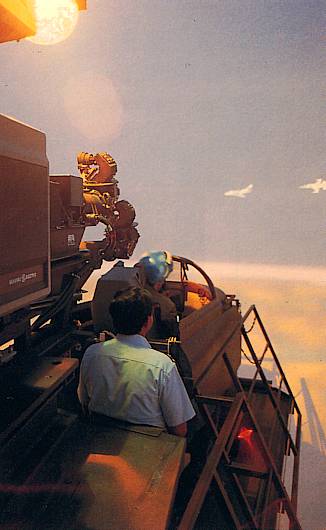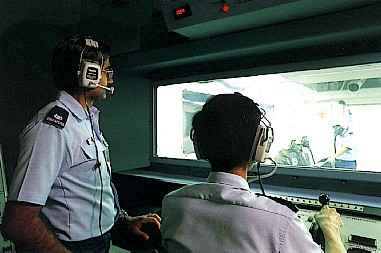 The school's
commanding officer, Major Koh Chai Hong, 39 , confirms that these are the trainees who
have been "chopped" -- airforce lingo for failing the course.
The school's
commanding officer, Major Koh Chai Hong, 39 , confirms that these are the trainees who
have been "chopped" -- airforce lingo for failing the course.Enter the instructors' lounge in the Republic of Singapore Air Force's Flying Training School in Seletar and you will see a room furnished with sofas, a bar counter and posters.
Lined up on one wall are neat rows of photographs of pilot trainees. Nothing unusual, except for that several are pinned upside down.
 The school's
commanding officer, Major Koh Chai Hong, 39 , confirms that these are the trainees who
have been "chopped" -- airforce lingo for failing the course.
The school's
commanding officer, Major Koh Chai Hong, 39 , confirms that these are the trainees who
have been "chopped" -- airforce lingo for failing the course.
She says: "There's not much point in keeping them on if they are not suitable, "sometimes, we have to tell a student, 'Sorry, you just don't have what it takes to be a military pilot'."
An RSAF public relations officer sitting in on the interview bristles. Failure is something the organisation would prefer not to talk about. Yet, it is something pilot wannabes have to face up to.
That long and expensive quest costs the RSAF about $2 million per pilot and takes about 2 1/2 years.
If he lasts the distance, the trainee gets to wear those precious "wings" on his green jumpsuit that tell the world: "I am an air force pilot."
The journey begins with a psychological test -- a computer game that determines his hand/eye coordination and ability to handle stress.
Then follows a rigorous medical test to check that he is the right
size. Too big and he might have problems ejecting in an emergency.
and he might have problems ejecting in an emergency.
Only half of those who apply make it to the school in Seletar, and these, one in five makes it to pilot.
Major (NS) Noel Tam, an aviation instructor there, puts it bluntly. "There's no second chance. If you make a mistake, that's it. You pack your bags. Go home."
Major Koh adds: "Some get very affected. They go through a period of depression after being chopped.
"Sometimes, there's anger... there's a certain loss of manhood. Some break down. Then, there is an acceptance because they are usually relieved at getting away from the pain of flying badly."
There is also the pain of losing the pay. Starting pay ranges from $1,584 to $3,792, depending on education level. On earning wings, a trainee may draw "$3,706 to $7,255 for a start", promises a recruitment brochure.
The pressure to perform is not necessarily just about pay or passing the course. Most dream of being fighter pilots.
"The cream of the crop tend to become fighter pilots because they have to work with faster machines and are expected to have quicker reaction time," says Major Koh.
"But that may change with our acquisition of combat helicopters," she adds, referring to RSAF's purchase of eight Apache attack helicopters.
Despite the danger, trainees prefer not to dwell on their mortality although they know their dental moulds are in the Aeromedical Centre for identification purposes. Lieutenant Roger Reid, 25, a trainee says: "If you have to go, you have to go. You could be sitting at a bus-stop and a bus ram into you."
Officer cadet Elvin Eng, 19, puts it another way. "If you're someone who loves flying, you won't be thinking about death. I'm free up in the air and yet, I'm in control."
(taken from The Straits Times, 16/6/99)